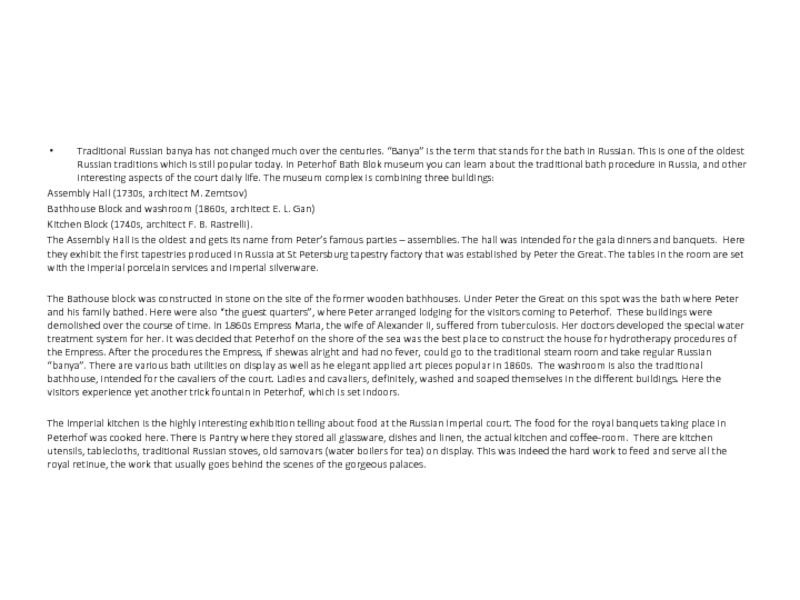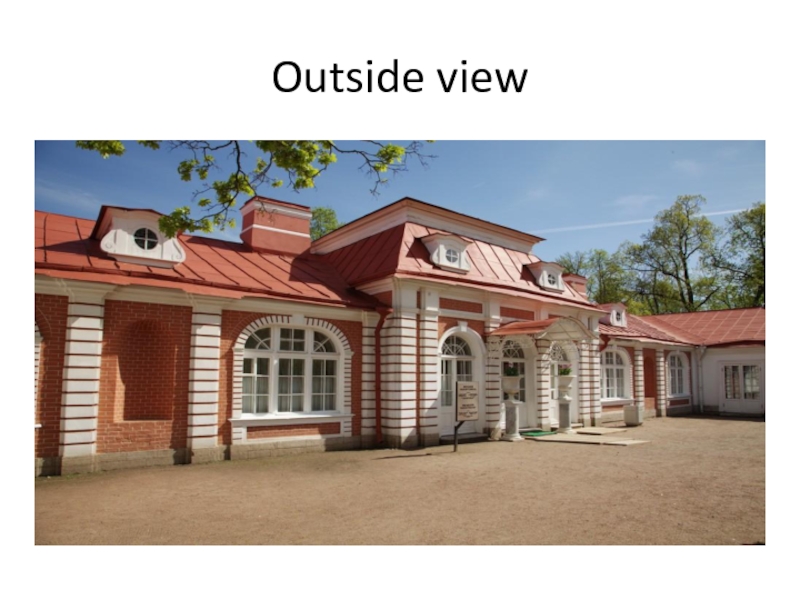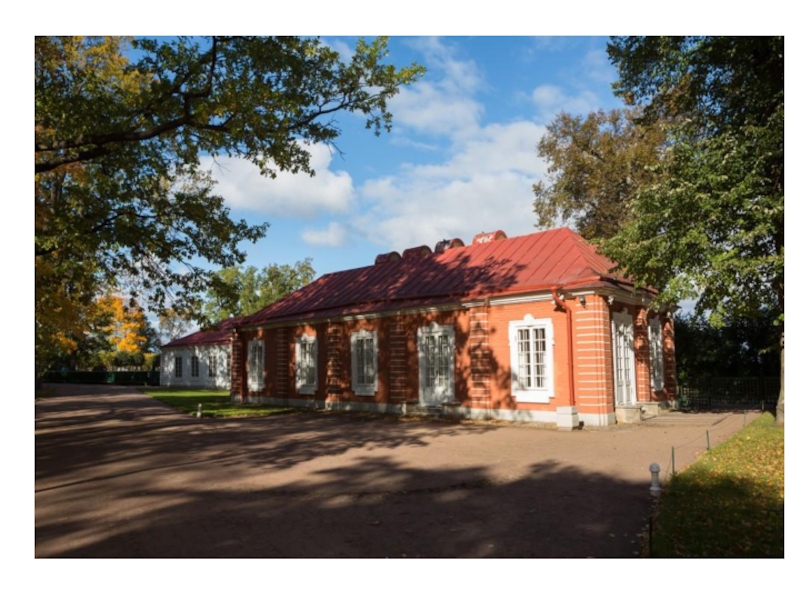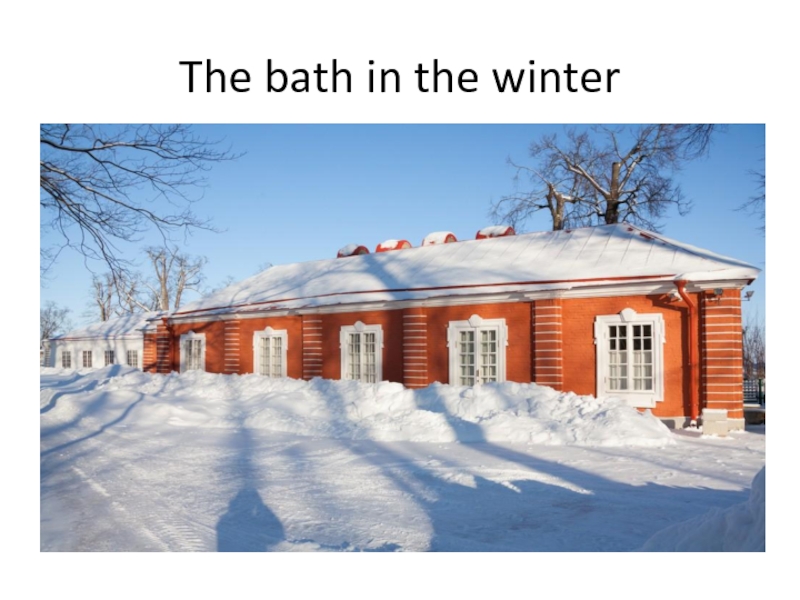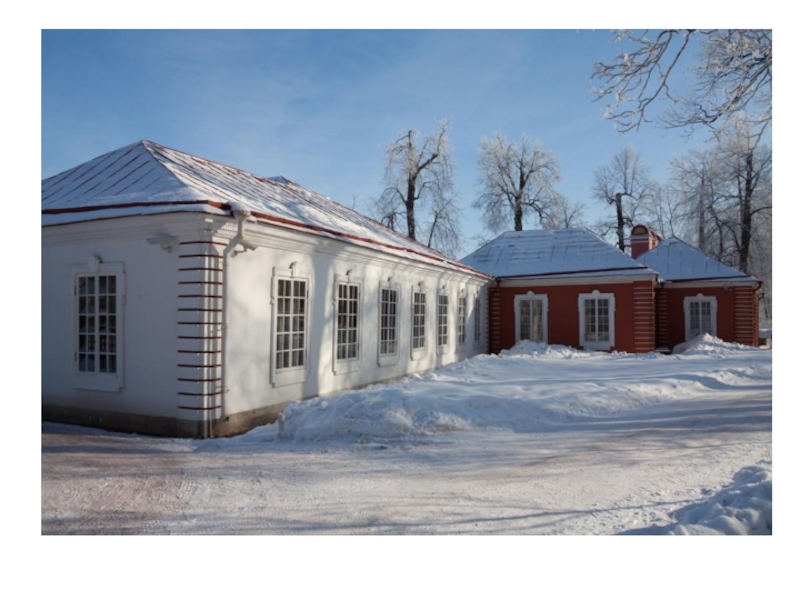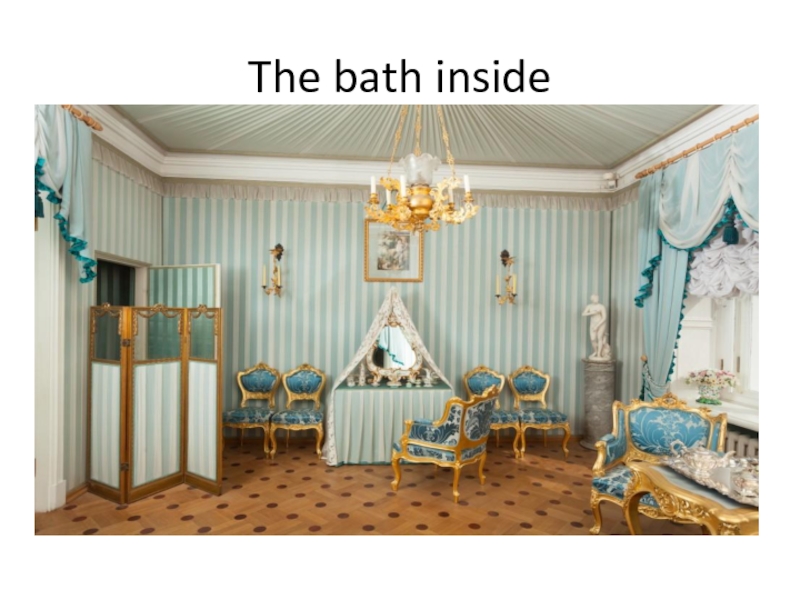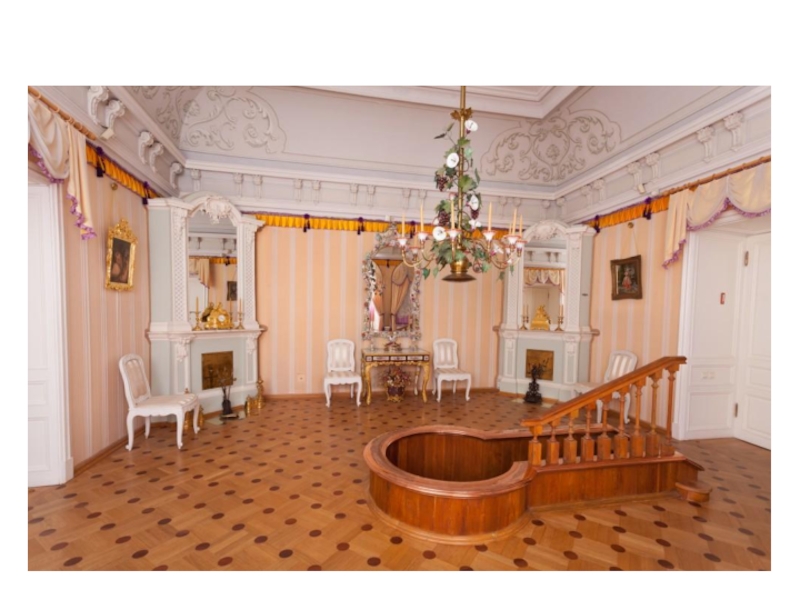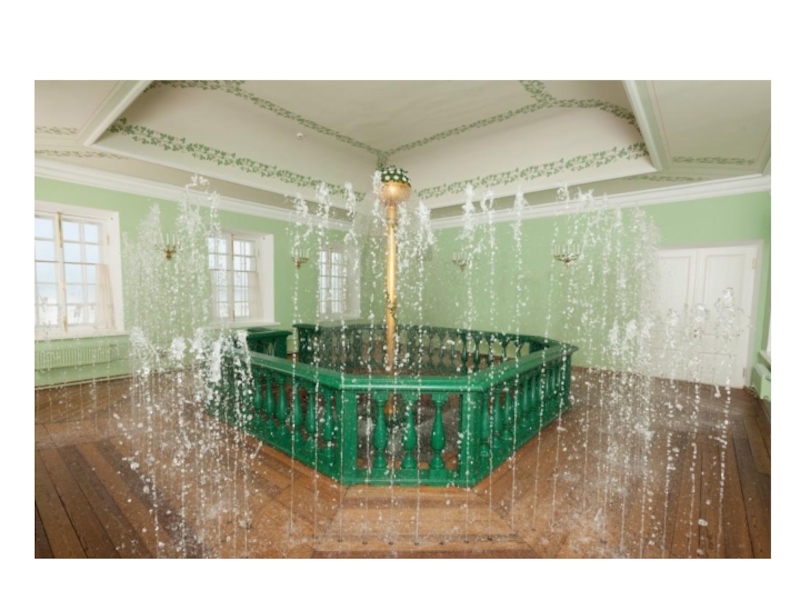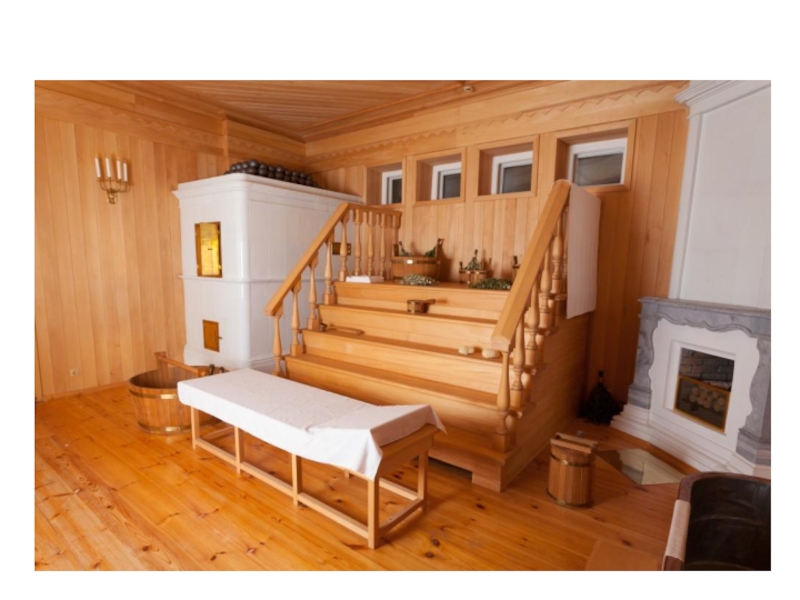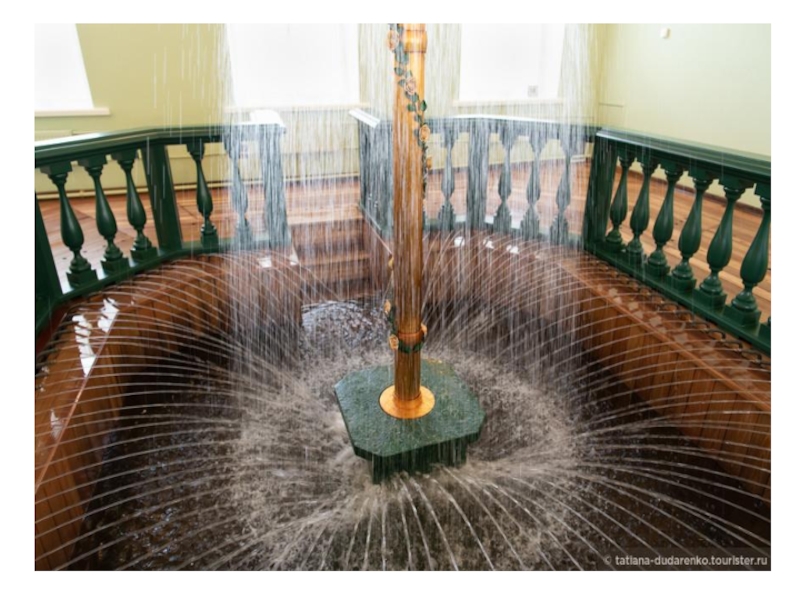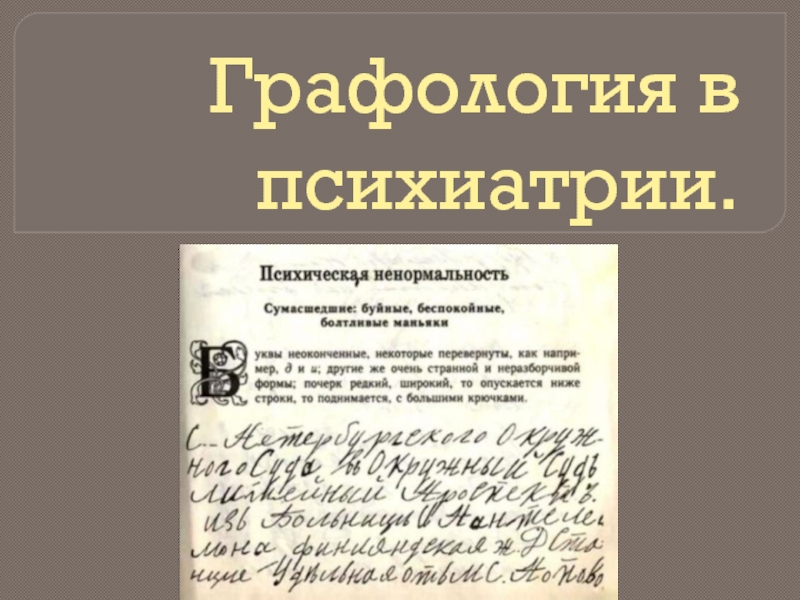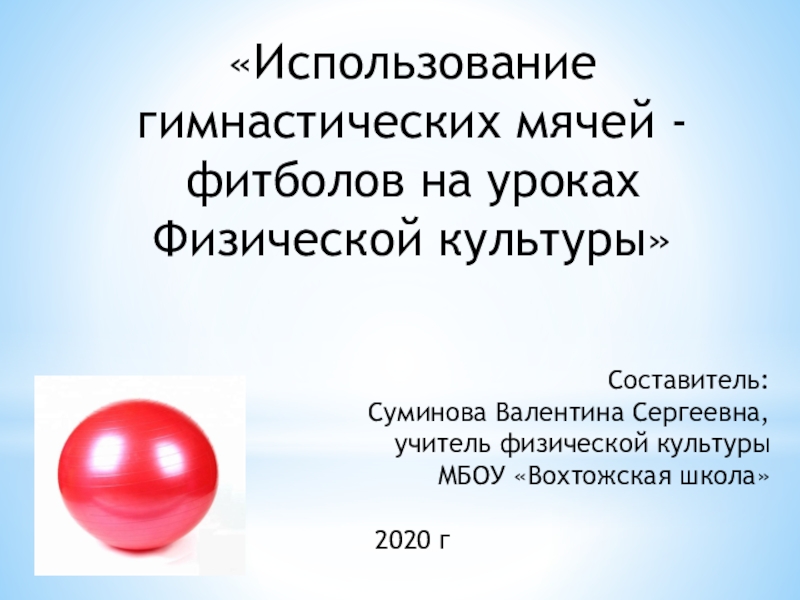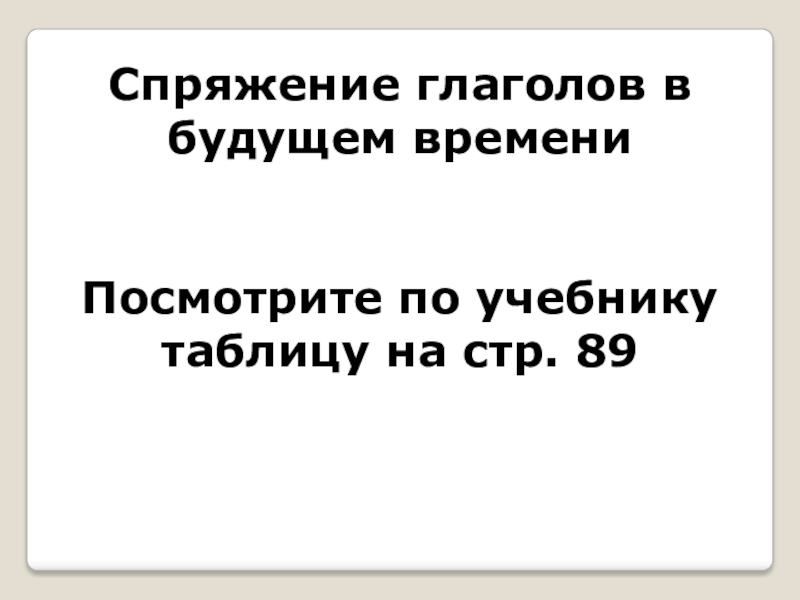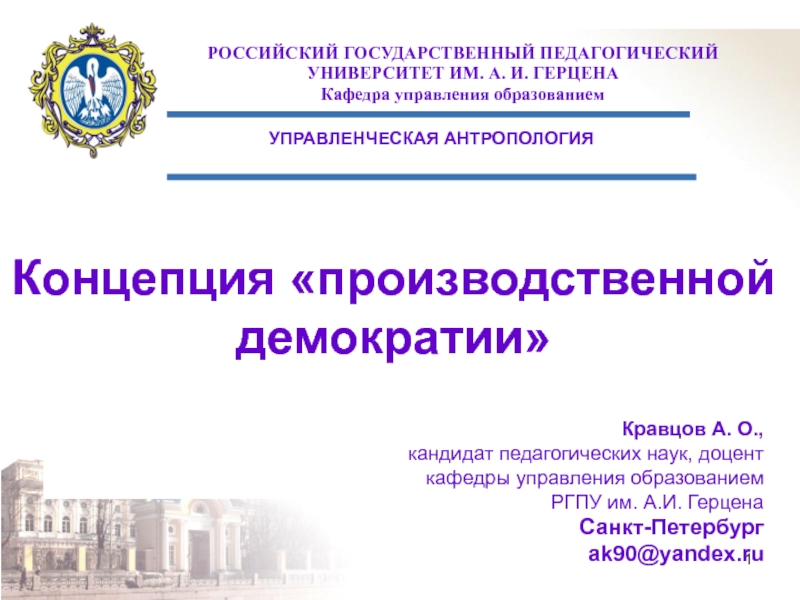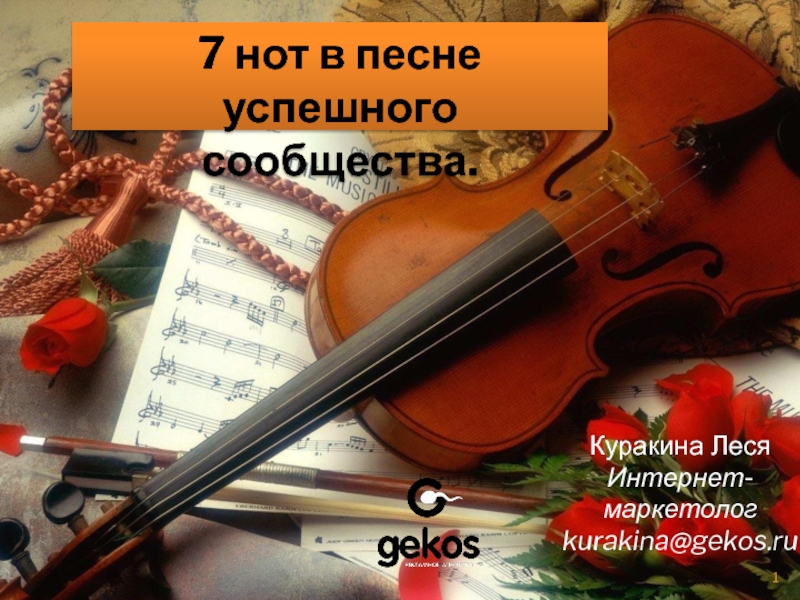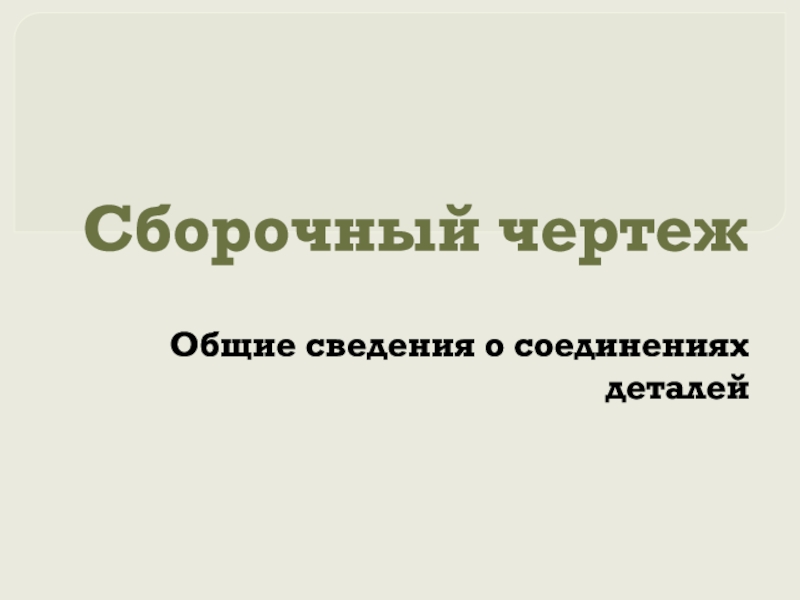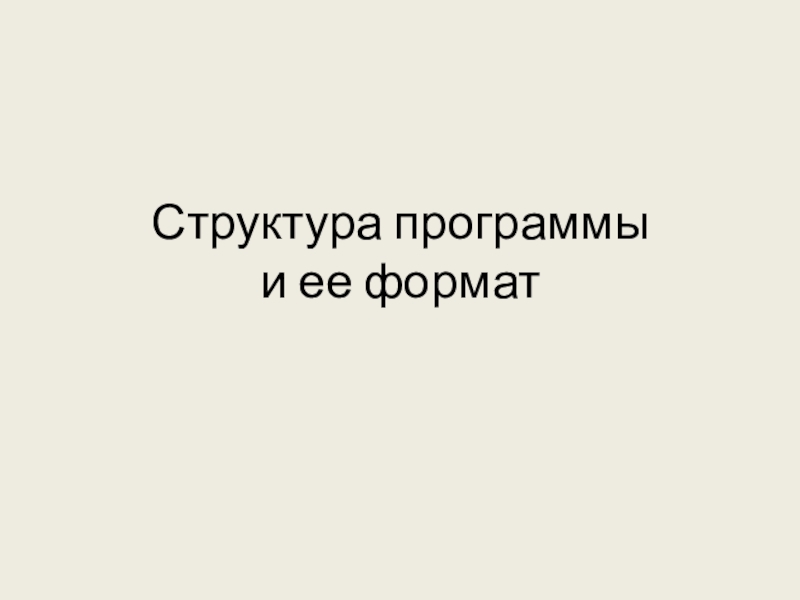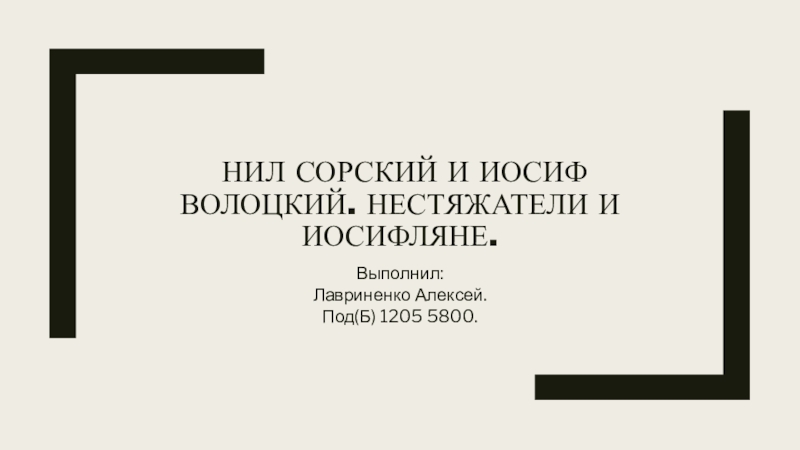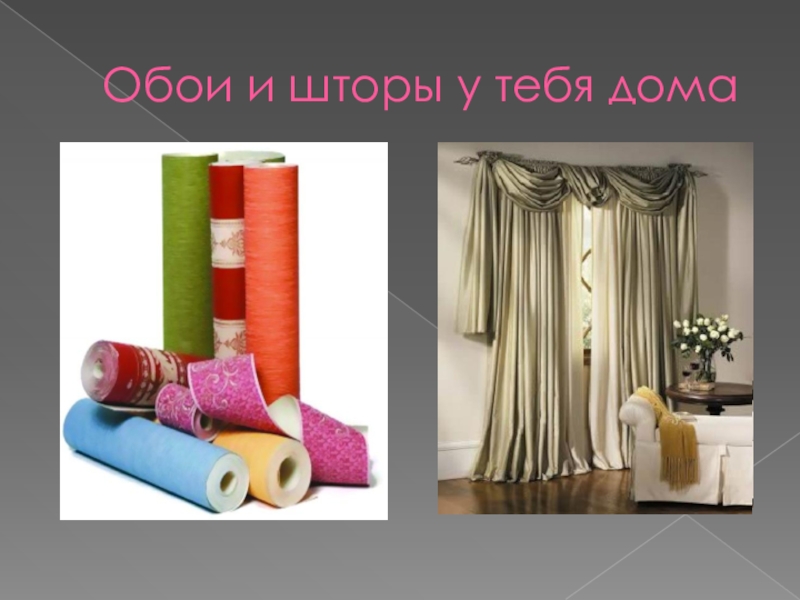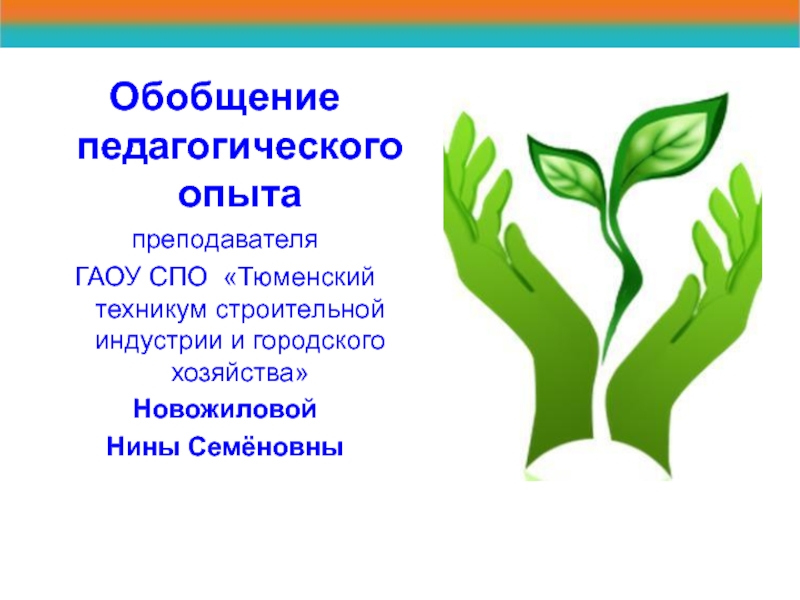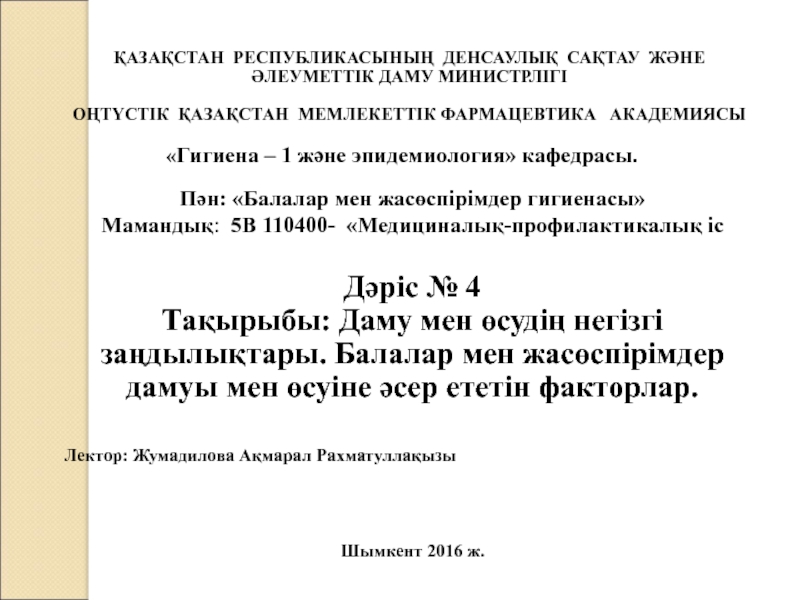Слайд 1
The Bath House
Attached to the eastern wing from the side
of the Monplaisir Garden is a single-storey building with a
tent-shaped hipped roof. This is the so-called Bath House. Originally, the Monplaisir estate included, among other household structures, bathing pools and baths built in 1721-22. In 1748, instead of Peter's small wooden bath house, a new one, also in wood, was erected there and a crystal bath inserted into a copper casing was installed. In 1765, the construction of a swimming pool with a lifting bottom and an inlet of sea water began. Unsalted water was fed from the Moujichok (Peasant) Fountain in the centre of the pool. The work was finished only in the 1770s when pipes were laid along the perimeter of the octagonal pool inside with water-jets spouting from them. Later, already in 1800, the moujichok was replaced by a tall gilded column with water-thrusting sphere on top. Thus the construction of a trick fountain over the Imperial bath was completed. In addition to the room containing a bathing-pool and a shower-bath, the Bath House had cold-water bathrooms and a Russian steam-bath, as well as the Toilet Room and the Entrance Room.
In 1865-66 the old wooden wing was replaced by a new stone building erected to the design of the architect Eduard Hahn. Redesigning the building he tried to retain the eighteenth-century style - he even simply imitated the architecture of Monplaisir. However, the evident lack of integrity in the design of the facades and the apparent overloading with details betray a nineteenth-century builder. Nevertheless, the architect left intact the original layout of the building, the bathing-pool with a fountain and the steam-bath. The Bath House had retained such an appearance until World War II, but during the occupation of Peterhof its interiors were destroyed. Now their restoration has been completed and soon a museum of the history of daily life shall be opened there.
A small Chinese garden in the so-called landscape style adjoins the Bath House from the east. The garden was designed by the architect Eduard Hahn in 1866. The creators of such gardens aimed at reaching the maximum variety of landscape scenery. To enliven the flat relief of the area, a hillock was raised there. Mounted on its top is a marble sculptural group, Cupid and Psyche, a copy of Canova's original. This spot affords a splendid view of the gulf. On the northern slope of the hillock is a tufa grotto with two marble stepways shaped as shells. The brook running from the grotto streams down the edges of the shells and feeds water to the small pond which has a tufa island with a fountain jet in the centre of it. The structure is known as the Shell Cascade. The clusters of trees, the small brook with humpbacked bridges spanning it, the marble statues, the winding walks and the flower-beds, all adds to the special air of cosiness and splendour characteristic of the Chinese Garden.
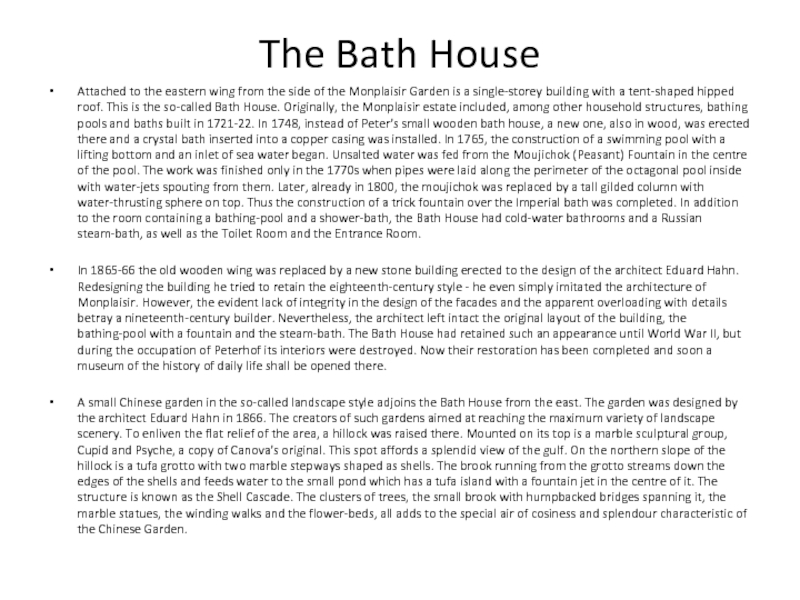
Слайд 2Bathhouse block, 1865-1866, architect E.L. Gan
Suds bath, 1800, architect D.Quarenghi,
1866, architect E. L. Gan
Assembly Hall, 1726-1732, architect M. Zemtsov,
1747, architect F.B. Rastrelli
Tablecloth pantry, Kitchen, Coffee Pantry, 1748-1750, architect F.B. Rastrelli
The museum is located on the territory of Monplaisir ensemble, it is a complex of buildings of ceremonial and domestic purposes, built at different times on the Eastern side of Monplaisir garden. The earliest construction related to Peter's time, is the Guest quarters or "the Quarters for the family", adjacent to the building of "Monplaisir". The guest quarters accommodated relatives and close friends of the emperor. Here you can view one of the rooms, designated for the tsar's guests, as well as to get acquainted with Peter's special "Points about Peterhof" - the rules that visitors had to follow.
There is a suds bath for the cavaliers adjacent to the guest quarters. It is located on the site of the first wooden bathhouse, built for Peter I. The records of the daily logbooks inform that, the tsar not only bathed in the Monplaisir bathhouse, but also held traditional medical manipulations, such as: taking medicine from crushed woodlice and worms, "let blood out". Inside the suds bath, there is a water surprise awaiting for the visitors, that they will be able to see in action.
The stone building of the bathhouse block was constructed in the second half of the XIX century, for the spouse of the emperor Alexander II, Maria Alexandrovna. The empress, who suffered from her lung diseases, took different procedures of hydrotherapy system, fashionable at that time in Europe. The Bathhouse block includes a Steam room - the traditional sweating room with the stove-heater, where instead of the stones, there is a pyramid of iron nucleuses. Next to the steam room, there is premises where the empress took warm baths and baths with concoctions of medicinal herbs. For cold water treatments there was a separate hall designated - the Cold bath, with an interesting exhibit of shower, disguised as an elegant chandelier from bronze and glass, decorated with bunches of grapes and flowers of bindweed.
Near the Bathhouse block, on the shore of the Gulf of Finland, a miniature landscape garden was laid out for the empress, later called the "Chinese Garden". The paths winding between the flowerbeds, meandering stream with thrown over hunchbacked bridges, marble statues, the small cascade and fountains - the most recent in the Lower Park by the time of their creation - are located on the small area of the garden. On the south side, the Bathhouse block is adjoined to a complex of buildings, consisting of the Grand Assembly Hall, the Tablecloth pantry, the Kitchen and the Coffee Pantry.
The Assembly Hall was named in the memory of the famous Peter's assemblies. Built on the site of Peter's Cooking chambers by the architect F. B. Rastrelli, it was intended for ceremonial dinners. The walls are decorated with unique tapestries, woven by Russian craftsmen in Petersburg in the first half of the XVIII century, and reproduce the scenes of the "Indian tapestries", received as a gift by Peter I during his visit to France, in 1717. The table in the center of the room is set with items of the Everyday service, made at the Imperial Porcelain Factory, in the late XVIII-early XIX centuries.
Dishes and table linen were stored in the Tablecloth Pantry (Tafeldekerskaya), where meals would get for serving through a distribution window from the Kitchen, equipped with Russian oven and stoves, with extractor tents for drawing out of the fumes. Unique kitchen utensils of the XVIII-XIX centuries are presented here. Specifically here, famous chefs prepared exquisite dishes for the tsar's table. And in the neighboring Coffee Pantry (Kofishenskaya), where you can admire a collection of antique, samovars, tea, coffee and hot chocolate were prepared.
Despite the fact, that the buildings of the complex were built at different times, stylistically they constitute a uniform ensemble with "Monplaisir" palace. The Bathhouse block is a unique museum, that offers visitors a rare opportunity to get acquainted with everyday aspect of the imperial court's life.
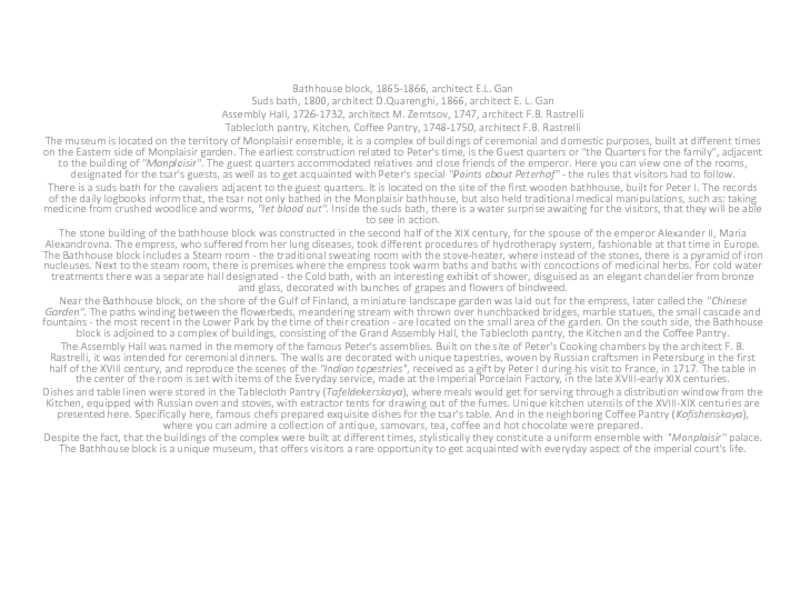
Слайд 3Traditional Russian banya has not changed much over the centuries.
“Banya” is the term that stands for the bath in
Russian. This is one of the oldest Russian traditions which is still popular today. In Peterhof Bath Blok museum you can learn about the traditional bath procedure in Russia, and other interesting aspects of the court daily life. The museum complex is combining three buildings:
Assembly Hall (1730s, architect M. Zemtsov)
Bathhouse Block and washroom (1860s, architect E. L. Gan)
Kitchen Block (1740s, architect F. B. Rastrelli).
The Assembly Hall is the oldest and gets its name from Peter’s famous parties – assemblies. The hall was intended for the gala dinners and banquets. Here they exhibit the first tapestries produced in Russia at St Petersburg tapestry factory that was established by Peter the Great. The tables in the room are set with the Imperial porcelain services and imperial silverware.
The Bathouse block was constructed in stone on the site of the former wooden bathhouses. Under Peter the Great on this spot was the bath where Peter and his family bathed. Here were also “the guest quarters”, where Peter arranged lodging for the visitors coming to Peterhof. These buildings were demolished over the course of time. In 1860s Empress Maria, the wife of Alexander II, suffered from tuberculosis. Her doctors developed the special water treatment system for her. It was decided that Peterhof on the shore of the sea was the best place to construct the house for hydrotherapy procedures of the Empress. After the procedures the Empress, if shewas alright and had no fever, could go to the traditional steam room and take regular Russian “banya”. There are various bath utilities on display as well as he elegant applied art pieces popular in 1860s. The washroom is also the traditional bathhouse, intended for the cavaliers of the court. Ladies and cavaliers, definitely, washed and soaped themselves in the different buildings. Here the visitors experience yet another trick fountain in Peterhof, which is set indoors.
The Imperial kitchen is the highly interesting exhibition telling about food at the Russian Imperial court. The food for the royal banquets taking place in Peterhof was cooked here. There is Pantry where they stored all glassware, dishes and linen, the actual kitchen and coffee-room. There are kitchen utensils, tablecloths, traditional Russian stoves, old samovars (water boilers for tea) on display. This was indeed the hard work to feed and serve all the royal retinue, the work that usually goes behind the scenes of the gorgeous palaces.
